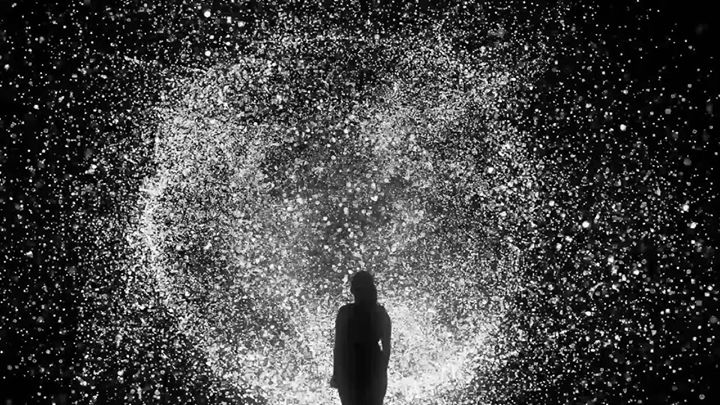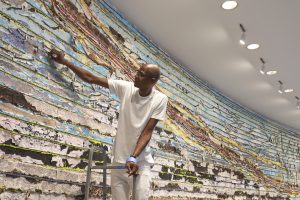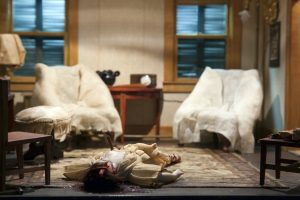Parallel Universe, ARTECHOUSE’s most recent exhibit presented in partnership with the Turkish art group Ouchhh, is a hypnotic fusion of art and technology defined by its endless dichotomies. Black and white, dark and light, full and empty, everywhere and nowhere—these are the contradictions that give Parallel Universe its untiring dynamism. The exhibit envelops visitors, wrapping them in sound and noise, and releases them about an hour later, unaware how much time has passed.
When visitors arrive at ARTECHOUSE, a docent greets them and leads the group down a winding stairwell deep into the belly of the building. As the group descends, visitors will begin to hear the rumble of deep bass, growing louder and louder with every step, until the curator stops to deliver the necessary epilepsy warning. Her speech is meaningfully punctuated by the thumps of bass, which visitors can feel as well as hear from behind the exhibit entrance door. When the doors open, the explosion of flashing lights and throbbing music makes it feel like walking into the maw of a monster.
The main exhibit space is about the size of a basketball court and has dozens of bean bag chairs scattered under three towering white walls that stretch to high ceilings. Mesmerizing projections of geometric designs fill the wrap-around walls, creating an immersive image that swirls around the viewers as they sink into bean bags. This is “Iota,” the centerpiece of Parallel Universe.
“Iota” takes minimalism to a grand scale, painting the walls in black and white patterns that are perfectly in sync with the pounding music. The first step in creating “Iota” was making the soundtrack, a docent explained. The sounds, an otherworldly combination of pounding bass and electronic beats, recall deep space exploration films and horror thrillers, instilling an alternating sense of unease and wonder. Ouchhh creators used this score as raw data for the visuals, running it through a number of sound visualization algorithms which, after being edited and curated, produced the projections on the walls. (thesaddleroomrestaurant.com)
These projections are dynamic to an extreme, constantly moving, transforming, and transitioning between designs all cast in stark monochrome. One second viewers are saturated in sliding geometric line patterns repeated a hundred times over, the next moment they are caught in a tangled web of curves that pulse to the music and wiggle with energy. Throughout the progression of images, the screen intermittently flashes pure white, creating a frenetic strobe light effect that is undoubtedly to blame for the epilepsy warning. “Iota” is a deep dive into a world of shapes and lines that smoothly meshes geometric and organic shapes to create a new world.
“Iota” peers into a new universe that runs parallel to ours, one that straddles the line between math and nature, between order and disorder. Despite sitting in the bean bag, the viewers’ sense of direction deteriorates as they are blasted with not only a series of different images, but also a series of different settings, all of which are imbued with manic energy and movement. One setting looks out at a bright white horizon that quickly zooms toward the viewer. Another is a mass of tentacle-like strands that reach toward the viewers until they are moving through the tendrils like a field of tall grass. Not only are the images themselves engrossing, but also the pacing gives viewers just enough time to absorb what they are seeing before snapping to a new segment. To avoid complete sensory overload, Ouchhh chose the simple black and white color scheme to allow each image, whether shown in minute detail or on a grand scale, to be digestible for viewers—at least visually.
After visitors are immersed in “Iota” for long enough, eyes wide and bodies shaking from the bass, they may need to steady themselves before moving into the next piece. “Portal” is a set of projections made especially for ARTECHOUSE’s hallway space. The exhibit is a transitional piece that simulates movement through space and time, quite literally paralleling the motion of visitors as they pass from one piece to the next. Walking through the dimly lit hallway is like bracing a tornado wind. Visual debris and messy shapes fly across the ground, walls, and visitors themselves.
Once museum-goers enter “Orion,” they are directed to one of the eight strategically placed bean bags that lay within a grid of swiveling spotlights mounted on iron poles. A large pyramid edged with bright LED lights hangs upside down from the center and lights the room. The pyramid, a reference to the pyramids of Giza, is the focus of the performance, highlighted by the many mobile spotlights that illuminate the apex. The performance begins with almost a dozen swiveling spotlights lining up—some viewers must turn around to see them—and forming the constellation Orion on one of the walls. The lights recall the theory that the ancient Egyptians made the pyramids of Giza line up with Orion, and after assembling on the wall they begin to scatter all over the room.
“Orion” is seven minutes long, and the full duration is underpinned by bass tones that are perhaps even louder than those in “Iota,” heightening the intensity of the piece. As each group experiences “Orion,” it is surrounded and targeted by the many spotlights that fly around them like foreign creatures made of pure light. Sometimes moving slowly, methodically, and geometrically within the grid, at other times darting between bean bags to land on viewers, the lights of “Orion” thrill with their sprightly dance. Each round of “Orion,” viewers are thrust into a world of living light and sound that feels both intimate and foreign.
Intimate and foreign is the essence of Parallel Universe, which creates an unreachable alien world that touches viewers in ways that they can understand: through sounds and images produced in the universal black and white. Through intense visual and audio simulation, viewers take a journey that seems to go everywhere and nowhere, deep into a void that is somehow full of life. Not for the faint of heart, Parallel Universe swallows visitors and spits them out again, a hauntingly beautiful beast of an exhibit.






